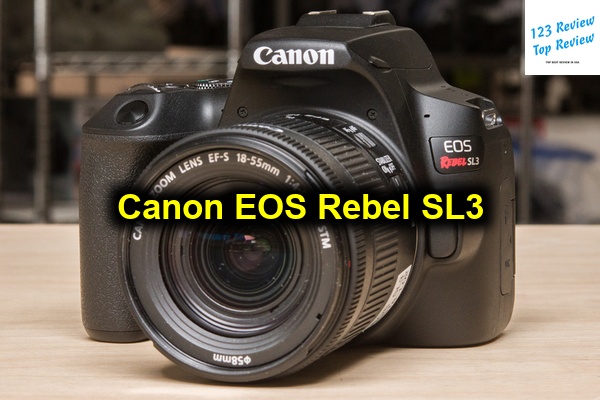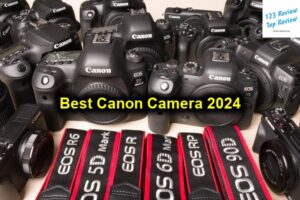The Canon EOS Rebel SL3, also known globally as the EOS 250D, embodies Canon’s successful formula of integrating powerful features into a compact and lightweight DSLR body. Ideal for beginners and photography enthusiasts, the SL3 bridges the gap between the simplicity of point-and-shoot cameras and the advanced functionalities of DSLRs.

In this article, 123 Review will delve deeper into the SL3’s design, performance, usability, lens compatibility, and competitive positioning to provide an exhaustive resource for potential buyers.
Design and Build Quality
Size and Weight
The Canon EOS Rebel SL3 holds the distinction of being the world’s smallest and lightest DSLR camera with a vari-angle screen. Weighing in at around 449 grams, including the battery and memory card, this camera is designed for comfort and mobility. Its dimensions of 122.4 x 92.6 x 69.8 mm make it incredibly portable, encouraging photographers to carry it along on all adventures, from local daytime strolls to extensive international travels. This lightweight design is a remarkable achievement for those desiring the feel and functionality of a DSLR without the burden of carrying heavy gear.
Material and Durability
Crafted from a durable polycarbonate resin and glass fiber body, the SL3 offers a good balance of strength and portability. While lacking the extensive weather sealing found in professional-grade cameras, the build quality is surprisingly robust given its weight, allowing it to withstand the rigors of daily use. Care should be taken in adverse weather, but the camera comfortably handles typical environments encountered by everyday photographers and travelers.
The Rebel SL3’s design prioritizes usability and longevity, making it a camera that easily endures the learning curve of beginners and survives the spontaneous demands of active shooters, whether photographing road trips or family events.
Key Features
24.1 MP APS-C Sensor
At the core of the SL3 is a 24.1-megapixel APS-C CMOS sensor. This sensor, combined with Canon’s DIGIC 8 processor, empowers the camera to produce high-resolution images with excellent detail, vibrant colors, and low noise. The APS-C sensor is significantly larger than those found in smartphones and many compact cameras, offering enhanced performance in controlling depth of field and capturing fine details, even in low-light conditions.
The SL3’s sensor excels in capturing the subtleties of natural landscapes, nuanced portraits, and high-paced action scenes. These capabilities make it a versatile tool for capturing a wide variety of subjects, from macro shots of flowers to sweeping vistas.
4K Video Capabilities
One of the standout features of the Rebel SL3 is its ability to shoot 4K video at 24 frames per second. This introduction to high-definition video allows entry-level users to delve into the world of 4K filmmaking without needing specialized equipment. However, it’s important to note that 4K shooting on the SL3 involves a crop factor, which effectively narrows the field of view, requiring photographers to adapt compositions accordingly, especially with wide-angle shots.
In addition to 4K capabilities, the SL3 supports Full HD video at 60fps, perfect for capturing smooth motion, whether filming dynamic sports events or serene nature documentaries. The availability of time-lapse video in 4K further expands creative possibilities, allowing users to explore artistic storytelling through condensed time sequences.
Dual Pixel Autofocus System
The SL3 is equipped with Canon’s acclaimed Dual Pixel Autofocus (AF) System, designed to deliver swift and accurate focusing for both stills and video. In the optical viewfinder mode, the SL3 offers 9 AF points, while in live view, the Dual Pixel AF extends across a wide area, ensuring precise tracking and sharp focus on moving subjects.
Notably, the inclusion of Eye Detection AF automates the focusing process during portrait photography, ensuring that the subject’s eyes are pin sharp — a critical feature for portraits that prioritize human expression and emotion.
Performance
Image Quality
The combination of a 24.1MP sensor and DIGIC 8 processor results in excellent image quality, with remarkable detail, sharpness, and accurate color reproduction across various lighting conditions. JPEG outputs are crisp and vibrant, requiring minimal post-processing for general purposes, while RAW files retain extensive data for photographers who desire full control over their images during editing.
The SL3 handles dynamic range competently, capturing highlight and shadow detail effectively, which is essential for landscape and architectural photography that manifests a broad spectrum of light and dark areas.
Low Light Performance
In challenging lighting environments, the SL3’s performance is notable. The camera’s ISO range stretches from 100 to 25,600, expandable to 51,200, allowing photographers to push the limits when shooting in dimly lit settings. The noise reduction software integrated into the SL3 ensures that even at higher ISO settings, the images sustain a level of clarity that is acceptable for casual to semi-professional use.
This proficiency makes the SL3 suitable for indoor events, dusk landscapes, and other scenarios where natural light is limited, allowing users to capture moments without excessive grain or loss of detail.
Autofocus Efficiency
Autofocus efficiency is a hallmark of the Rebel SL3, benefiting from Canon’s Dual Pixel technology which facilitates quick focus adjustments and tracking. The camera’s autofocus system is reliable across a spectrum of photographic scenarios, from fast-paced action shots and candid street photography to precise macro and portrait work. The Eye Detection autofocus further enhances its ability to deliver in situations where precision is of utmost importance, such as portraiture and wildlife photography where catching the moment is crucial.
Usability
User Interface and Controls
One of the primary attractions of the SL3 is its user-friendly interface and controls. The camera features a straightforward layout with essential controls easily reachable, making it intuitive even for those unfamiliar with DSLR operation. The vari-angle touchscreen LCD is a notable asset, supporting straightforward touch operation for menu navigation, touch focus, and image viewing. This touchscreen functionality allows for interactions similar to smartphones, facilitating quick adjustments without diving deep into complex settings.
The screen’s ability to tilt and swivel also provides flexibility in composing shots from creative angles, whether for high, low, or selfie perspectives, making it a versatile tool for both photographic and video production purposes.
Beginner-Friendly Features
Canon has loaded the Rebel SL3 with beginner-friendly features that demystify photography’s complexity. The Creative Assist mode offers accessible settings for experimenting with depth of field, brightness, and saturation adjustments in a user-friendly interface, while Guided Mode provides step-by-step assistance and tutorials that enhance learning.
These features are ideal for novice photographers, helping them build confidence and develop their technical skills over time. They support an experiential learning curve, which is critical for retaining engagement and fostering creativity.
Battery Life and Charging Options
Battery life is often a concern for photographers, and the SL3 excels in this area. The camera’s LP-E17 battery offers around 1,070 shots per charge when using the optical viewfinder, which is outstanding among its peers and benefits those planning extended shooting sessions without worry of running out of power. For video shooting or extensive live view usage, the count remains respectable, making it suitable for events like weddings and full-day excursions.
One limitation is the lack of USB charging capability; the camera relies on an external charger for the LP-E17 battery. While this might be less convenient for travelers, the overall battery lifespan offsets this drawback for typical use cases.
Lens Compatibility
Available Lens Options
The Canon EOS Rebel SL3 is compatible with Canon’s extensive lineup of EF and EF-S lenses, providing a vast arsenal of photographic tools to explore numerous genres and styles. This compatibility means that users can access a wide variety of lenses perfect for macro photography, wildlife, sports, landscapes, and beyond.
Additionally, Canon’s continuous innovation in the lens market ensures users can find lenses with the latest features, optical stabilization, and improved autofocus motors.
Recommendations for Starter Lenses
For new Canon SL3 owners, several starter lenses are well-suited for a range of photographic styles:
- Canon EF-S 18-55mm f/4-5.6 IS STM: This versatile kit lens offers a balanced focal length perfect for everyday scenes, from landscapes to portraits.
- Canon EF 50mm f/1.8 STM: Known as the “nifty fifty,” this prime lens is excellent for portrait photography, offering sharp images and beautiful bokeh to isolate subjects effectively.
- Canon EF-S 55-250mm f/4-5.6 IS STM: Ideal for those exploring wildlife or sports photography, its telephoto reach captures distant subjects with precision.
These lenses collectively provide a well-rounded foundation, enabling photographers to explore creativity and develop their portfolio across diverse settings.
Competitive Comparison
Comparison with Canon EOS M50
Contrast with the Canon EOS M50 reveals differences that align the SL3 for traditional DSLR enthusiasts, while the M50 appeals to those desiring the compactness of a mirrorless system. The SL3’s optical viewfinder and greater battery life favor long-day shootings, while the M50’s higher frame rate burst shooting and advanced autofocus system appeal to high-speed photographers.
Both cameras share similar sensors and image quality capabilities; however, the choice between the two frequently depends on the user’s preference for DSLR vs. mirrorless ergonomics and additional features.
Comparison with Other Entry-Level DSLRs
When compared to the Nikon D3500 and Pentax K-70, the Canon SL3 offers a modern feature set appealing to today’s budding photographers. The D3500 offers excellent image quality and longer battery life, but lacks 4K video capabilities. Meanwhile, the Pentax K-70 provides extensive weather sealing for a competitive edge in durability but is less compact than the SL3.
The SL3 stands out with its beginner-friendly features, lightweight design, and the inclusion of cutting-edge autofocus technology, presenting itself as a go-to choice for users on the threshold of expanding their photographic journeys.
Conclusion and Recommendations
Best Use Cases
The SL3 is ideally suited to a variety of photographic applications, from travel photography where its lightweight design and long battery life make it the perfect companion, to videography projects leveraging its 4K capabilities. It is excellent for family or street photography, where spontaneous composition remains key, and excels in portrait or pet photography due to its real-time autofocus benefits.
Target Audience
New photographers eager to expand skills and dive deeper into creativity will find the Canon EOS Rebel SL3 an invaluable tool. It is perfect for enthusiasts looking to learn manual settings, explore the world of interchangeable lenses, or transition from smartphone to a more serious camera platform. Furthermore, seasoned photographers seeking a reliable backup camera will appreciate the SL3’s portability and comprehensive feature set.
Overall, the Canon EOS Rebel SL3 shines as an approachable yet sophisticated DSLR that provides flexible functionality and respectable image quality, making it a versatile asset for a creative journey into photography and video production. It stands as a highly recommended choice for anyone entering the DSLR realm and aspiring to capture beautiful, enduring images.





